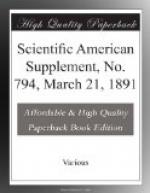Oil dressing or Indian dressing—which merely differ in application, but are founded upon the same principle—is the most simple method of curing skins. The principle of each is the soaking of the gelatine fibers of the skin with oil, the union of the latter and the gelatine appearing in the form of oxide, and resulting in the insoluble, undecomposable, pliant, and tough material known to the commercial world as leather. The first step in the oil dressing, after the skins have been duly soaked to render them porous and absorptive, is to cover them with fish oil and place them in the stocks or fulling machines—huge wooden hammers with notched faces working in iron cases—where they are beaten and turned, and subjected to a uniform pressure until the oil is gradually absorbed. After taking them out, hanging them up, and stretching them, the oil and fulling process is repeated according to the thickness of the skin, and until every part of it is full of oil. After this the skins are dried in a mild heat that causes the oxidization of the oil. This being completed, all the superfluous oil is removed by putting the skins in an alkali bath. Then the curing process is complete.
With the preparation of kid leather alum is the astringent curative agent. Its operation is accompanied by that of others whose purpose is to secure elasticity and pliability, and mainly to preserve that beautiful texture which makes kid leather superior to all others. These assistants in the process are eggs, flour, and salt. They are combined into what is called a custard. A proper quantity of the custard and a number of skins having been put together in a dash wheel, where they are thrown about for some time, the open pores of the skin absorb the custard freely, and become swelled by the chemical union of the custard and the skin. In trade parlance this swelling is known as “plumping.” This having progressed satisfactorily, the skins are folded together with the fleshy side outward, and are dried by a gentle heat.
They are now cured, but they are yet hard and rough. Another objectionable feature is that they are of unequal thickness. Breaking and staking, as they are called, are now resorted to, to make the skins soft, pliable, and of even texture, removing the superfluous chemicals with which they become charged, and the stiffness by manipulating the fibers. Much trained skill and dexterity, especially in knee and arm staking, are required in the stretching, which is the essential




